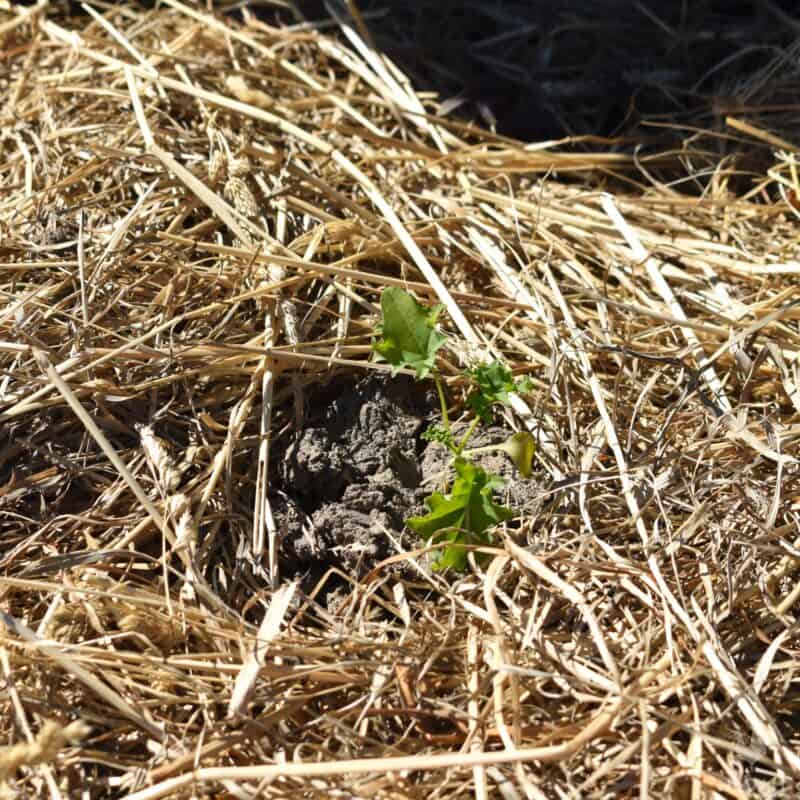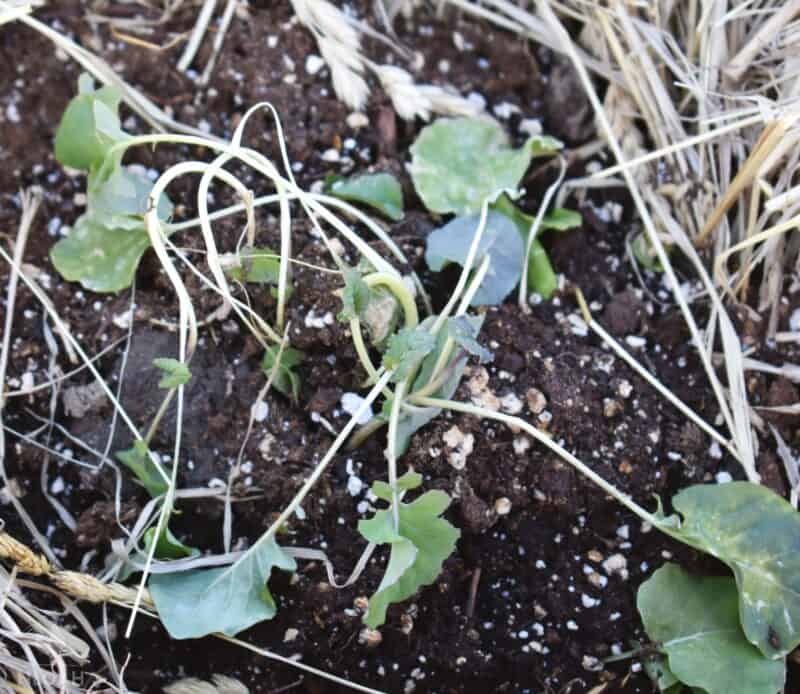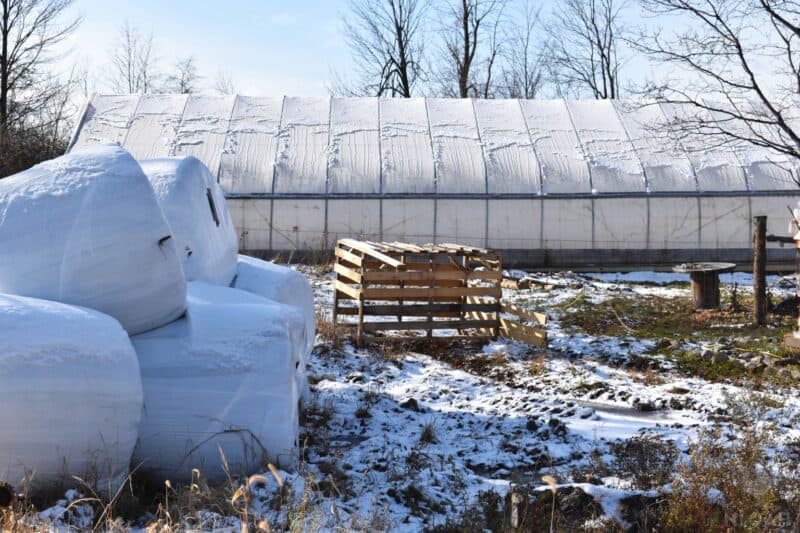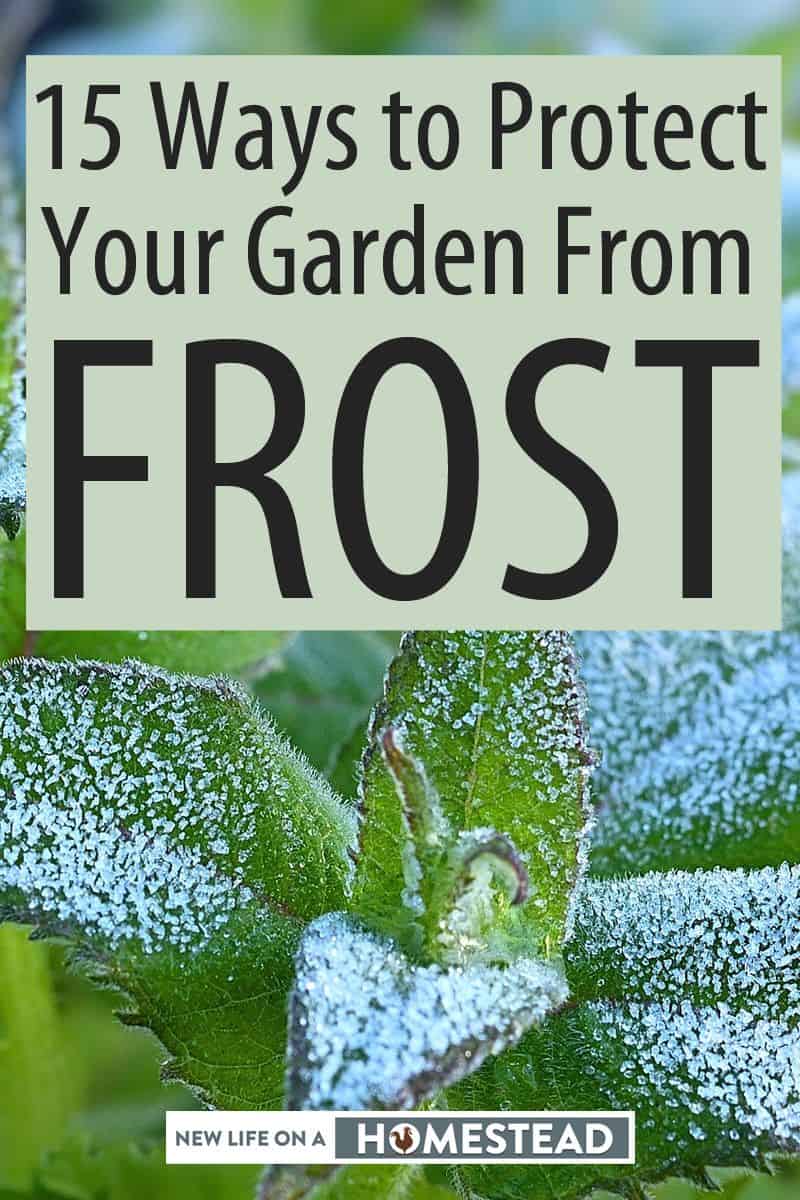I finally finished planting the last round of tomatoes, eggplant, and peppers in the hoophouse! It’s still summer, so it might seem odd that I am planting in an insulated greenhouse.
However, I’m trying to plan ahead for November – when I plan to still be enjoying juicy homegrown tomatoes fresh from the garden.

Where I live (Ohio), that’s unheard of (unless you have a greenhouse, of course). That’s because our first frost usually comes in early October, so gardeners find themselves scrambling to pull plants from the ground by the end of September or risk losing their crop.
When you’re planting your delicate seeds or tender young seedlings in the spring and enjoying the warmth of the springtime sun on your face, the winter frost might be the last thing on your mind.
However, it’s important that you plan ahead for the first frost. Time your plantings appropriately, and consider these helpful tips as you’re figuring out how to protect your garden from frost.
Here’s what you need to know.
Why is Frost a Problem?
There are several ways in which frost can injure your plants.
First, it creates ice crystals in your plant cells. This makes water unavailable to the tissues of your plants, and makes it hard for fluids to move about the plant.
As a result, leaves that are damaged by frost look as though they are soaked in water before shriveling up and turning black or dark brown.
Some plants are considered “hardy” and can tolerate some short-term freezing. “Tender” plants are those that are killed by even the slightest indication of cold weather, like succulents, citrus and avocados.
A frost can occur at any temperature below 32 degrees F (0 C). I recommend protecting against a frost if temperatures are expected to be as high as 35 or 36 degrees F (1.5 – 2.5 C) – you never know when the forecast will be slightly off! You don’t want to gamble.
Figuring Out Which Plants Need Frost Protection
Truth be told, not all plants need protection from a light (or even heavy) frost. In fact, some plants can survive even under a blanket of snow. Brussels sprouts are just one example – in fact, I planted my brussels sprouts too early this year, and they lived through a snowstorm the following week!
However, any warm weather crops like peppers, tomatoes, eggplant, and squash need to be protected from freezing temperatures and frost conditions. In reality, it’s not necessarily the cold weather that kills these plants, but the crippling frost that ensues.
That said, plants that don’t mind the cold include:
- spinach,
- kale,
- brussels sprouts,
- cabbage and broccoli
- most root vegetables (like carrots and potatoes).
- and more.
Vegetables in the brassica family, in fact, taste sweeter after prolonged periods of cold weather.
You usually don’t need to cover these crops, but any other vegetables need protection from a freak early fall frost.
Consider Where You Plant
Consulting your plant hardiness zones is important when you’re trying to figure out which of your plants can tolerate a light frost – but remember that every property is unique.
There is even some variation within growing zones and within individual properties. One chunk of your land might not have the same climatic conditions as another, believe it or not.
Your landscape will have its own unique “microclimates.” There are various features in a microclimate that can affect plants, including elevation, soil properties, canopy cover, the proximity of other plants or structures, and surface reflectivity, that can all affect heat radiation.
Try not to plant tender crops in open, exposed areas or in low lying areas where cold air tends to settle.
Instead, plant these vegetables near west- or south-facing walls, where heat will be absorbed during the day and radiated out at night. You can also plant near fences, shrubs, and boulders for additional protection in the cold.
A garden that slopes toward the sun will warm up more during the day. The residual heat in soil and in plants may determine, by and large, whether your garden surfers frost damage.
Not only will a garden on a south-facing slope have more exposure to the sun, but it will drain cold air better, too.
Similarly, trees around your garden will act like a blanket and reduce how much heat radiates from your soil (as long as they don’t create too much shade).
Cover Them Up
The most obvious – and easiest – way to protect your plants from a frost is to cover them up. You have a few options for doing this.
The easiest way is to make a quick frost cover. You can use items you have around your home, including plastic sheeting, canvas tarps, towles, bits of burlap, old tablecloths, old blankets, or old sheets.
Just be careful when doing this, as you don’t want the frost covers to be placed directly on top of your plants. The weight of the blankets can damage them. Plus, there does need to be a small amount of air space between your covers and your plants.
Otherwise, the cold temperatures and moisture will be passed right on to the leaves of your plants, rendering all of your best efforts useless.
You can easily make some simple wire hoops to keep the blankets or covers off your plants. Just secure the edges with bricks, stones, or sandbags.
This is the best option if you are expecting a frost for only a night or two, since these covers can be cumbersome to take on and off.
If you anticipate a week or more of cold weather – but then it will warm up later on – you can use fabric row covers. You’ll need to buy these, but they are much better suited for long term use.
There are multiple styles available, including those that are intended for light frost, heavy frost, and even summer use.
Fabric row covers are meant specifically for use in the garden. They are lightweight, and won’t harm your plants. They let water, light, and air pass through, so you don’t have to take them off each day, either.
Build a Cold Frame
If you have a bit of time before the frost rolls in, consider using a cold frame. A cold frame is often likened to a portable greenhouse. It’s smaller and much shorter, however.
You can make a cold frame or buy a ready-made structure. Either way, a cold frame will provide the necessary heat and insulation around your plants to shield them from the upcoming frost.
You will need to remove the old frame once the weather warms, though, so you don’t cook your plants.
Pay Attention to Soil Quality
If you’re rushing around, and trying to prepare your plants for a frost that’s expected to hit tonight, unfortunately, this tip won’t help you out much! But if you’re designing a garden for longterm frost protection, consider this – good soil helps to create a buffer against frost.
A soil that is rich and filled with organic matter will not only retain moisture better, but it will also reduce the rate of evaporation from the soil.
Similarly, raised beds warm up more quickly and stay warm faser. That’s because they have better drainage and you’ll have more control over the growing conditions.
Consider a Cloche
A cloche is a small glass or plastic cover that you place over the top of a plant to protect it from a frost. In theory, it works much like a cold frame – except it is placed over a single plant instead of all of them at once.
You’ll put the cloche on top of your plants after the sun has gone down and remove it first thing the next day. They’re great for protecting seedlings.
Again, you can buy a cloche or build your own. I made a few makeshift cloches last year out of old wate rugs that I cut in half. It worked great to protect my tender young broccoli seedlings from the snowstorm that I mentioned above.

Water Your Plants
Believe it or not, watering your plants can help shield them from some level of frost damage. Of course, it won’t provide all the protection they need, but it can help to bolster their defenses.
The reason for this is that wet soil holds more heat than dry soil. As your soil releases moisture overnight, it will elevate the temperatures around your plants. Don’t soak the soil – just give the plants light watering in the late afternoon just before things start to cool down.
Use Water Jugs To Warm Your Plants
Fill up a few plastic jugs with water before placing them in the sun. here, they’ll be able to soak up heat during the day.
Just before dusk, put the jugs around your plants and toss a cover over them. The water will lose heat more slowly than the air and soil, and it will emit warmth as it does so.
Mulch
Mulch has so many benefits for the average gardener. Not only can it protect your plants from a light frost, but it suppresses weeds and retains moisture, too.
When you mulch your soil, it will help your soil stay warmer to insulate your plants. You can use any kind of mulch, including straw, hay, wood chips, or even grass clippings.
Use a Heat Lamp
Depending on where you have your plants growing, you may be able to use a small 100-watt lamp designed for outdoor use in the interior of a tree. This can send out enough warmth to reduce frost damage.
Some people use holiday lights, too, but you’ll need to be careful about making sure they don’t touch any covering materials (this is a fire hazard).
Purchase an Anti-Transpirant
You may be able to seal in moisture using an anti-transpirant spray. These are usually available for sale at local nurseries. These help protect plants for up to three months by coating their leaves with a protective film. It won’t necessarily get you through the winter, but it can help buffer the impacts of early frosts.
Cluster Container Plants
If you’re growing a large group of container plants, your best bet is to just bring them all inside during frosty weather. There, they’ll be protected from theft.
However, if there’s some reason why you can’t move your containers, just cluster them together. They’ll create a little “heat island” that will provide some protection from the cold.
Harden Off Your Seedlings
This tip won’t help much with an early fall frost, but it’s vital as you’re preparing for a frost in the spring. Make sure you harden your seedlings off before planting them! This will involve gradually exposing your plants to the outdoors and the outdoor conditions to help them withstand the challenges of early spring.
Start hardening your plants off about 14 days before your transplant. Start with just an hour or two of hardening off per day, then build up until your plants are ready to plant.
Wrap Your Trees
When it comes to protecting trees from the frost, you’re going to have to act a bit differently. Young trees – typically those between one and four years old – are generally much more likely to suffer from frost injury.
The blossoms and buds of fruit trees in particular, when exposed to a spring frost can suffer from stunted growth.
To protect trees from cold weather, wrap their trunks with burlap, rags ,cardboard, or towels. Start at the base of your tree trunks and wrap around, overlapping the layers by a few inches.

Get a Greenhouse
If you have a bit of time and money to spare, consider investing in a greenhouse. This will allow you to dramatically extend your growing season so that you can plant long before the last expected frost – and long before the first one in the fall, too.
Watch the Clouds
A good way to tell if a frost is coming? Watch the clouds. Cloudy nights offer more insulation, helping to protect the ground from sudden fluctuations in temperature.
Clear skies, on the other hand, allow heat to escape. Although calm conditions are more likely to reach a freezing point than windy ones, wind can dry out your plants and make them more susceptible to frost, too.
Don’t Overreact
Of course, you should do everything in your power to protect your plants from frost. But if a frost forecast slips by you and you happen to wake up the next morning to see your plants looking wilted or somewhat lifeless, don’t panic – plants are remarkably resilient, especially those that are well-established.
In my Brussels sprouts scenario I told you about before, I also panicked after the snowstorm and pulled the sprouts up in frustration. They didn’t look so hot – in fact, most of them looked dead. My husband encouraged me to wait it out, and I’m glad I did.
If your plants appear a bit lifeless, leave them alone for a few days. Don’t prune them or dig them up. Let the weather warm up – you might see your plants bounce back. I’m happy to report that mine did!
When you’re planning ahead for a frost in the fall, remember that the first early frost is often followed by several weeks of frost-free weather. Therefore, if you take a few steps to protect your plants, you may be able to get a few more “bonus” weeks of additional gardening.
Good luck!


Rebekah is a high-school English teacher n New York, where she lives on a 22 acre homestead. She raises and grows chickens, bees, and veggies such as zucchini (among other things).
